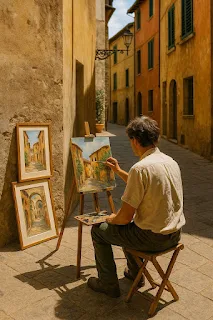Italy’s Quiet Artistic Renaissance: Beyond the Canals and Colosseum
Posted: July 8, 2010
When we talk about art in Italy, our minds often race to the big
names—Michelangelo, Da Vinci, Botticelli. We think of marble sculptures, Roman
architecture, and oil paintings hanging in world-famous museums. And while
those masterpieces still leave us breathless, there’s a new wave of creativity
moving quietly through the country, almost unnoticed.
Today’s Italian art scene isn’t about grandeur—it’s about subtlety,
storytelling, and soul.
It’s the kind of art you find tucked into backstreet studios, small-town
galleries, and pop-up exhibitions in old train stations. It’s graffiti on
Venetian alleyways, photographs in abandoned factories, and spoken word poetry
in Florence basements. It’s a movement rooted in heritage but pushing into new,
personal territory.
The Shift from Monumental to Minimal
There’s a sense that Italian artists today are moving away from monumental
expression and into more human-scale, relatable work. Instead of making art to
impress emperors or clergy, they’re making art to reflect daily life—and it’s
incredibly powerful.
In places like Bologna and Palermo, you’ll find artists exploring topics like
migration, identity, gender, and family with quiet intensity. Their materials
are often modest—wood, canvas, old magazines, glass shards—but the effect is
anything but small.
One painter I met in Naples told me, “We already have the monuments. What we’re
missing is the voice of the street.”
Old Spaces, New Energy
A fascinating thing about this artistic renaissance is where it’s happening.
Many Italian creatives are transforming historic spaces into living studios.
Churches, warehouses, and centuries-old homes are becoming community art hubs.
I visited a repurposed textile mill in Turin that now hosts monthly
exhibitions, open mic nights, and workshops for children. The walls still smell
of dust and dye, but they now echo with the sounds of storytelling,
brushstrokes, and laughter.
There’s something poetic about seeing modern art breathe inside a 19th-century
building—it’s like the past and present are collaborating.
A Generation Finding Its Voice
This movement isn’t backed by big institutions—it’s powered by individuals.
Many of the young artists I’ve spoken with don’t come from art school
backgrounds. Some are self-taught, others trained in photography, fashion, or
even engineering. But what unites them is a desire to create something honest
and relevant.
They aren’t chasing fame. They’re chasing truth.
Some are using found materials, creating pieces entirely out of recycled
plastic or leftover industrial scraps. Others are documenting their
neighborhoods through photo essays or zines. One group in Rome even started a
traveling art cart that wheels through the city like a gallery on wheels.
---
Technology Meets Tradition
Italy has always held tightly to its traditions—but today’s creators are
blending old and new in unexpectedly elegant ways.
You’ll see stop-motion animations made with handmade puppets, websites built to
archive local dialects, or street murals that reinterpret Renaissance portraits
in spray paint and chalk.
Even Instagram (which is just beginning to gain traction here in 2010) is being
used to showcase work and connect artists across regions. It’s still a humble
space, but it’s quickly becoming a gallery without walls.
The South is Speaking Louder
While Milan and Florence remain cultural capitals, much of
this contemporary artistic voice is coming from the southern regions—Naples,
Bari, Calabria, and Sicily.
Here, art often doubles as activism. It speaks to economic struggle, political
disillusionment, and the tension between staying and leaving. These pieces feel
raw and necessary. They don’t ask for applause—they ask for attention.
And people are starting to listen.
The Tourist’s Blind Spot
What surprises me most is how little of this makes it into guidebooks. Tourists
still flock to the Vatican and the Uffizi (as they should), but they often miss
the living, breathing art happening all around them.
A graffiti mural on a side street in Bari might say more about modern Italian
identity than any statue could. A hand-painted sign in Sicily, protesting the
closure of a local library, might carry the legacy of protest art forward in a
more meaningful way than we realize.
Italy isn’t just a museum. It’s still making art—and that art is evolving.
Final Thoughts from the Train Window
As I write this, I’m watching vineyards blur past my train window. The sun is
setting somewhere behind Siena, and the light has that soft gold glow that painters
try to capture but never quite can.
Italy is still beautiful. But more than that, it’s still creative.
This new generation of Italian artists isn’t competing with the masters.
They’re adding to the story. Their tools may be different, their scale may be
smaller—but their voice is just as powerful.
If you're ever in Italy, look beyond the postcards. Step off the main road.
Visit the alley. Peek into the doorway. Somewhere in there, you’ll find a new
kind of masterpiece.
And it won’t be made of marble—it’ll be made of now.
